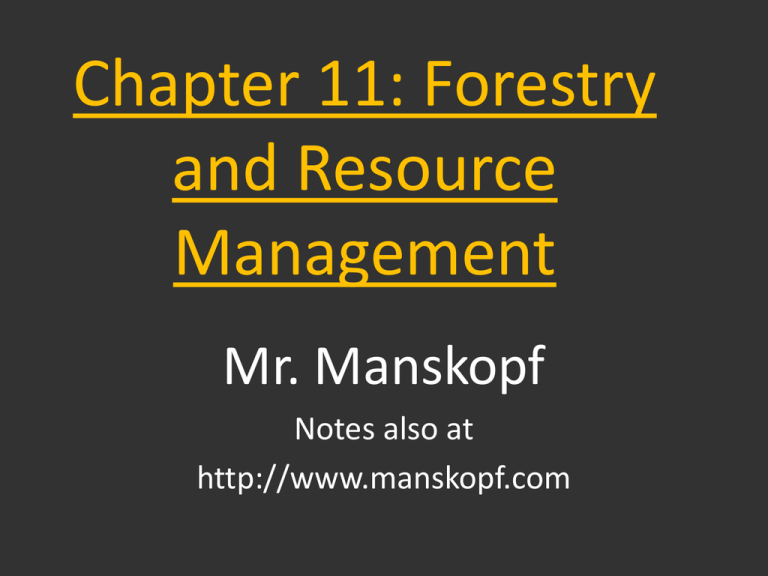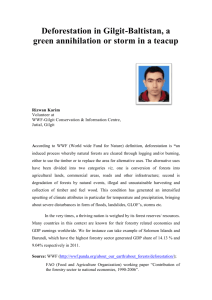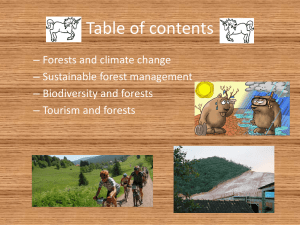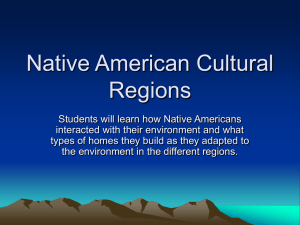Chapter 11: Forestry and Resource Management
advertisement

Chapter 11: Forestry and Resource Management Mr. Manskopf Notes also at http://www.manskopf.com Essential Questions Covered • Describe the impact of human activities on the land. • What are some local and federal laws governing land usage. Section 1 Resource Management • Explain the importance of managing specific renewable resources. • Describe several resource management approaches. Renewable Resource Management • Resources are either renewable, such as soil, or nonrenewable, such as fossil fuels. • Goal is sustainability— resource use that occurs only as fast as can be naturally replaced. What are some examples of RENEWABLE RESOURCES? Renewable Resource Management Must balance human and ecological needs What are some of our economic and ecological needs in: • Forests • Wild animals • Clean water • Soil 1)Maximum Sustainable Yield (MSY) Goal: To harvest maximum resources without compromising future harvests PROBLEMS: • MSY can affect interactions between species and alter entire ecosystems. • Determining target population size is largely a matter of trial and error. 2) Ecosystem-Based Forest Management • Goal: To harvest resources while minimizing effects on the rest of the ecosystem • Ecologically sensitive areas are carefully monitored and protected; resources are harvested selectively. Ecosystem Based Management PROBLEM: Ecosystems are complex, so choosing which areas to protect and which to harvest is a challenge. Requires a lot of ecosystem knowledge 3) Adaptive Forest Management • Goal: To gather data from areas managed in different ways, and develop a customized management plan based on the results • Management practices are continually monitored and adjusted. • Can be time-consuming and may require changing established practices Section 1 Review • Explain the importance of managing specific renewable resources. • Describe several resource management approaches. Section 1 Quiz 1) Renewable resources include soil, fresh water, wild animals, and A. minerals. B. coal. C. timber. D. petroleum. 2) Which approach to resource management aims to harvest resources in ways that minimize impact on the ecosystem and processes that provide the resource? A. maximum sustainable yield B. ecosystem-based management C. adaptive management D. watershed management 3) A renewable resource is harvested sustainably if A. the amount of replacement is less than the amount harvested. B. the amount of replacement is equal to the amount harvested. C. soil erosion is prevented. D. replacing trees costs less than harvesting trees. Short Answer 4) Pick one of the types “Management Approaches” (Maximum Sustained Yield, Ecosystem-Based or Adaptive) and explain at least 1 pro and con of that approach. Section 2 Forests and Their Resources • List several ecological and economical values of forest resources. • Describe the costs and benefits of different methods of timber harvesting. • Analyze impacts of deforestation around the world. Value of Forests •Ecological value: •Provide habitat for organisms •Source of biodiversity •Prevent erosion •Purify water •Store carbon, release oxygen Value of Forests Economic value: •Timber for lumber and fuel •Source of food •Raw material for many medicines Timber Harvesting Methods Three Methods • Three methods: Clearcutting, seed-tree or shelterwood approach, and selection system • May result in even-aged or uneven-aged regrowth • Even-aged regrowth tends to be less biodiverse than uneven-aged regrowth 1) Clear Cutting • Involves cutting down all trees in a region, resulting in even-aged stands of regrowth • Changes abiotic conditions in the area, including light penetration, precipitation, wind, and temperature Clear Cutting • Benefit: Cost efficient • Costs: Entire communities usually displaced or destroyed; causes soil erosion. 2) Seed-Tree and Shelterwood Approaches •Seed-tree: Small numbers of mature, healthy trees are left standing, to reseed the area. •Shelterwood: Involves leaving a few mature trees standing to provide shelter for seedlings Shelterwood Seed-Tree and Shelterwood Approaches •Benefit: Less damaging than clear-cutting •Cost: As with clearcutting, leads to mostly even-aged regrowth Selection Logging 3) Selection Logging •Relatively few trees are cut at once under a selection system. •Selection can involve widely spaced single trees or groups. Selection Logging • Benefits: –More biodiverse, uneven-aged growth –Less overall environmental damage • Costs: –Machinery disturbs forest interior. –Expensive process –More dangerous for loggers Deforestation •Deforestation in tropical and arid regions has the most negative effects due to loss of biodiversity and desertification risk respectively. •Globally, deforestation adds CO2 to Earth’s atmosphere Deforestation in U.S. •Deforestation for timber and farmland facilitated U.S. expansion. •By the early 1900s, very little old-growth forest (forest that has never been logged) remained in the United States. Old-Growth Forests • Have never been logged • Contain rich species diversity Worldwide Deforestation • Timber from old-growth tropical rain forests is a source of income in developing nations. • Advanced technology enables deforestation to occur far faster • Deforestation of tropical rain forests has an enormously impact on global species diversity. Before and After Desertification Deforestation •Decreased soil fertility from erosion •Runoff of eroded soil into aquatic systems •Premature extinction of species with specialized niches •Loss of habitat for migratory species such as birds and butterflies •Regional climate change from extensive clearing •Releases CO2 into atmosphere from burning and tree decay •Accelerates flooding Section 2 Review • List several ecological and economical values of forest resources. • Describe the costs and benefits of different methods of timber harvesting. • Analyze impacts of deforestation around the world. Section 2 Quiz 1) One disadvantage of the selection system of timber harvesting is that it A. produces even-aged stands. B. produces a monoculture. C. causes soil erosion. D. is more dangerous for loggers. 2) Deforestation is particularly harmful in arid regions because it can lead to A. desertification. B. a massive loss of biodiversity. C. loss of jobs. D. a decrease in greenhouse gases. 3) Which type of forest most likely contains the greatest variety of habitats? A. old-growth forests B. even-aged stands C. plantations D. monocultures Short Answer 4) How do forest plants prevent soil erosion? 5) Which method of timber harvesting leads to the greatest unevenaged stands of regrowth? 6) Which method of timber harvesting is likely to be most costly for a timber company? Why? Section 3 Forest Management • Explain how logging is managed in U.S. National Forests. • What impacts does fire suppression in U.S. forests have? • What are ways consumer demand impacts forestry practices? Figure 11-6b Page 198 National parks and preserves National forests (and Xs) National wildlife refuges Figure 11-6a Page 198 National parks and preserves National forests (and Xs) National wildlife refuges • Most logging in the U.S. takes place on private land, but timber companies are also allowed to harvest trees in National Forests under supervision by the U.S. Forest Service. U.S. National Forests Today, managed Originally set aside by to the U.S. Forest Service, for established in 1905 grow trees timber, recreation, for timber wildlife habitat, and mining National Forest Management Act (1976) •Requires that resource management plans be made for each national forest •Plans are required to be consistent with the principles of multiple use and maximum sustainable yield. NFMA Logging has declined in national forests since passage of the Act, but policies are vulnerable to political influence Fire Policies What is the cause of most forest fires? Surface fire Crown fire Fire Suppression •Negative effects on ecosystems that depend on fire •Fuel for future fires accumulates (limbs, sticks, and leaf litter). •Suppressing small fires increases likelihood of larger, dangerous fires. Fire Suppression Prescribed Burns: * Carefully controlled burning helps to reduce fuel buildup and to restore ecosystems. •Rarely burn out of control, but occasional accidents frighten the public. Sustainable Forestry Products • Independent organizations certify that wood products are produced sustainably. • Forest Stewardship Council (FSC) has the strictest standards and most widely accepted certification process. • Certified wood costs more to produce, but will be supplied by timber companies if there is demand. Section 3 Review • Explain how logging is managed in U.S. National Forests. • What impacts does fire suppression in U.S. forests have? • What are ways consumer demand impacts forestry practices? Section 3 Quiz 1) Prescribed burns are fires that A. are caused by lightning. B. are set by humans. C. never get out of control. D. increase the risk of injury. 2) The National Forest Management Act A. requires plans for national forests that follow multiple use and maximum sustainable yield guidelines. B. requires plans for national forests that follow multiple use and ecosystem-based management guidelines. C. encourages prescribed burning as a means of protecting national forests. D. promotes the removal of small trees and underbrush by timber companies. 3) Smokey the Bear’s message resulted in A. an increased number of forest fires. B. an increase in biodiversity. C. suppression of all forest fires. D. a loss of lives. 4) Fire suppression can result in a(n) A. increase in animal habitats. B. buildup of material that fuels future fires. C. decrease in property damage. D. an increase in the jack pine population. 5) Prescribed burns A. are carefully controlled. B. cannot be controlled. C. cause fuel buildup. D. cause permanent damage to ecosystems. 6) If a wood product is certified by the Forest Stewardship Council, it was produced A. using sustainable methods. B. from trees grown on a plantation. C. from recycled materials. D. because consumers demanded it. The End










